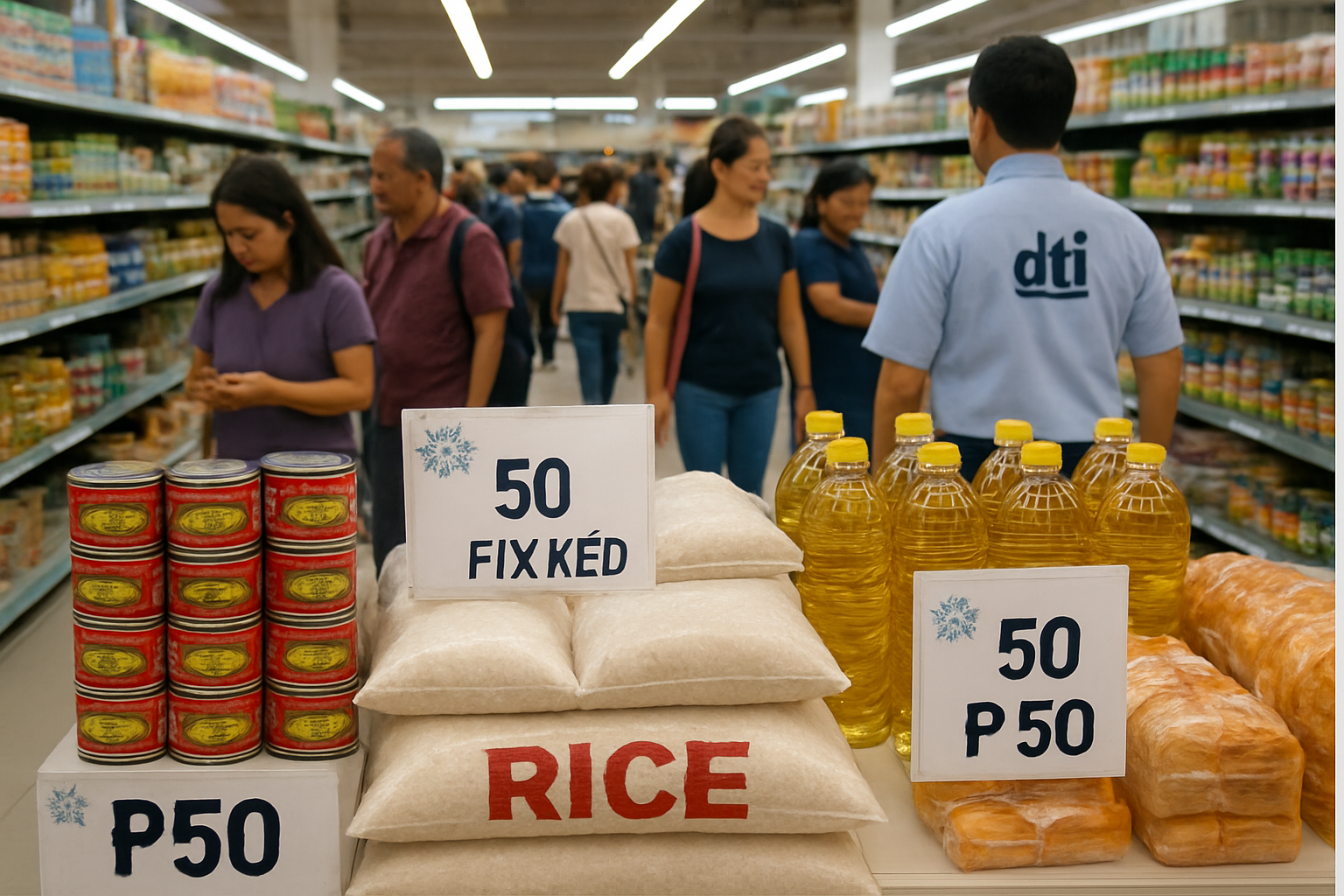
MANILA, Philippines – October 27, 2025 – President Ferdinand Marcos Jr. has issued a nationwide order to freeze the prices of basic necessities and prime commodities across the Philippines, effective immediately until the close of 2025. This decisive government intervention, announced today, October 27, 2025, aims to stabilize market prices and shield Filipino consumers from unwarranted price increases, particularly as the economically significant holiday season approaches. The Department of Trade and Industry (DTI) has been tasked with stringent monitoring and enforcement, ensuring the accessibility and affordability of essential goods for every household.
The presidential directive is a proactive measure to safeguard consumer welfare amidst persistent inflationary concerns and the economic aftershocks of recent natural calamities. By capping prices on a wide array of essential products, the Marcos administration seeks to alleviate the financial burden on citizens and prevent potential price gouging during a period of heightened demand and spending.
Unpacking the Presidential Edict: Details, Timeline, and Initial Receptions
President Marcos Jr.'s order mandates a strict price freeze on a comprehensive list of basic necessities and prime commodities as defined by Philippine law. These include, but are not limited to, canned sardines, canned meats, various types of milk, coffee, bottled water, instant noodles, bread, salt, soy sauce, fish sauce, vinegar, and candles. Furthermore, the DTI is specifically instructed to enforce maximum suggested retail prices (SRPs) for imported rice and other critical food items, reflecting the government's acute focus on food security.
The timeline leading up to this nationwide freeze reveals a pattern of government vigilance over commodity prices. President Marcos Jr. signed the order on Saturday, October 25, 2025, just prior to his departure for the 47th Association of Southeast Asian Nations (ASEAN) Summit in Kuala Lumpur, Malaysia, where the official announcement was made by Palace Press Officer Undersecretary Atty. Claire Castro. This broader directive follows a 60-day localized price freeze in Cebu on October 1, 2025, enacted after a magnitude 6.9 earthquake, demonstrating the government's readiness to use price controls in crisis situations. Notably, this also comes after Executive Order (EO) 100, signed on October 25, 2025, established a floor price for palay (unmilled rice) to support farmers, highlighting a dual approach to balancing producer welfare and consumer affordability.
Key players in this intervention include President Ferdinand Marcos Jr. as the initiator, and the Department of Trade and Industry (DTI), led by Secretary Ma. Cristina Aldeguer-Roque, as the primary implementing and enforcement body. Manufacturers and industry stakeholders are crucial partners, with DTI Secretary Roque reporting their cooperation in maintaining price stability. Consumers stand as the ultimate beneficiaries, while agencies like the Department of Energy (DOE) also play a role in monitoring specific items like LPG and kerosene in related price freezes.
Initial reactions from the industry, as conveyed by the DTI, suggest a cooperative stance. Secretary Roque indicated that industry stakeholders are working closely with the government to ensure fair and reasonable prices, especially during the Christmas holidays. While no immediate widespread negative market reactions have been reported for this specific nationwide freeze, historical precedents, such as the September 2023 rice price cap (EO 39), have occasionally drawn concerns from critics about potential market distortions, hoarding, and adverse impacts on small retailers.
Corporate Crossroads: Winners and Losers in the Price Freeze Landscape
The nationwide price freeze on basic goods presents a complex financial landscape for publicly listed companies in the Philippines, creating both significant challenges and limited opportunities until the end of 2025. The most direct impact will be on their revenues and profit margins, as they are legally constrained from adjusting prices even in the face of rising operational costs.
Companies with high exposure to the price-frozen categories and significant reliance on imported raw materials are likely to be the most affected "losers." This includes major players like Century Pacific Food, Inc. (PSE: CNPF), a leading producer of canned goods (tuna, sardines, corned beef) and milk, and Monde Nissin Corporation (PSE: MONDE), dominant in instant noodles and biscuits. These companies will find their profitability squeezed if input costs for raw materials (e.g., wheat, milk powder, fish, coffee beans), packaging, energy, and transportation continue to climb. The inability to pass on these costs will directly compress profit margins, potentially leading to lower net profits and subdued stock performance. Operational adjustments might include "shrinkflation" or reformulating products to use cheaper ingredients, risking brand reputation.
Conversely, "winners" or less negatively impacted entities might include highly diversified conglomerates such as San Miguel Food and Beverage Inc. (PSE: SMFB). As part of the larger San Miguel Corporation, its broad interests beyond basic food items (e.g., beer, spirits, packaging, infrastructure, energy) could help offset potential losses from price-controlled food segments. Companies with exceptionally strong cost control, highly efficient supply chains, or significant export operations (like CNPF's tuna exports) may also fare better, as their export revenues would not be subject to domestic price caps. Additionally, businesses that can quickly pivot to products not classified as basic necessities or focus on premium segments might find some insulation. Overall, the freeze will test the operational resilience and financial flexibility of companies in the consumer staples sector, with investors likely to favor those with robust balance sheets and diversified income streams.
A Wider Lens: Broader Implications and Historical Echoes
President Marcos Jr.'s price freeze extends beyond immediate consumer relief, signaling broader shifts in industry dynamics and regulatory approaches. This intervention aligns with a global trend of governments taking more direct roles in managing market stability, especially for essential goods, in response to persistent inflationary pressures and geopolitical uncertainties. The DTI's close coordination with manufacturers points to an evolving relationship where businesses are increasingly expected to collaborate with the government in maintaining price equilibrium, potentially absorbing rising input costs.
The ripple effects of this policy are far-reaching. Manufacturers and producers face limitations on their ability to adjust pricing, which could lead to tighter profit margins if operational costs continue to escalate. This pressure might deter long-term investments in capacity expansion or innovation within the affected categories. Retailers, similarly, will be unable to raise prices, potentially affecting their profitability and, in extreme cases, leading to reduced stock levels if procurement costs become unsustainable. While consumers benefit from stable prices in the short term, prolonged controls could inadvertently lead to reduced product availability or a decline in quality. Importers, in particular, could face challenges if global commodity prices rise while domestic selling prices remain fixed, a situation exacerbated by a weakening Philippine Peso.
From a regulatory standpoint, the price freeze reaffirms the government's commitment to utilize tools enshrined in the Republic Act No. 7581, or the "Price Act." This law empowers the government to impose price freezes during emergencies or states of calamity, and the current nationwide directive demonstrates the administration's readiness to intervene decisively to protect consumers. This could set a precedent for similar interventions in response to future economic shocks or inflationary pressures.
Historically, the Philippines has seen similar governmental interventions. President Marcos Sr., the current president's father, also implemented price controls in the 1970s through the Price Control Council. The Price Act itself, enacted in 1992, codified these powers, which have been used in various localized instances following natural disasters. The current freeze, therefore, is not an isolated event but rather an application of established governmental powers, reflecting a continuity in the Philippine approach to managing essential commodity prices during challenging times. While intended to provide stability, historical experiences with price controls often underscore the delicate balance between immediate consumer protection and the potential for long-term market distortions and supply issues.
The Road Ahead: Scenarios and Strategic Shifts
The price freeze until year-end 2025 sets the stage for a critical period for the Philippine economy and its consumer-facing industries. In the short term, the measure is expected to temper headline inflation and provide immediate relief to consumers, potentially bolstering purchasing power for the holiday season. However, this comes with the risk of supply disruptions if manufacturers find it unsustainable to produce at fixed prices while input costs climb. The DTI's vigilant enforcement will be key to ensuring compliance and preventing artificial shortages.
Looking beyond 2025, the long-term possibilities are varied. An optimistic scenario sees the freeze successfully stabilizing prices without significantly deterring investment, allowing the economy to maintain its projected growth trajectory (around 5.6% in 2025 and 5.5% in 2026). A more moderate, and perhaps most likely, scenario suggests temporary consumer relief, but with some strain on specific businesses and potential minor supply adjustments. The risk of a price rebound after the freeze is lifted in 2026 is also a significant consideration, necessitating careful monetary policy adjustments from the Bangko Sentral ng Pilipinas (BSP). A pessimistic outlook could see market distortions, widespread shortages, and erosion of investor confidence if the controls lead to severe profitability issues for producers.
Businesses, especially those in the retail and food and beverage sectors, will need to consider strategic pivots. Supply chain optimization to reduce costs and improve efficiency will be paramount. Diversification towards products not covered by the freeze or higher-margin offerings could become a survival strategy. Strict internal cost management and even process innovation will be crucial. Stronger engagement with government agencies to articulate challenges and seek support will also be vital. Market opportunities might emerge for brands that can maintain quality at fixed prices, or for new players who can adapt more nimbly. Conversely, challenges include reduced profit margins, potential supply shortages, and investor hesitation due to perceived market interference.
Navigating the Current: A Comprehensive Wrap-Up for Investors
President Marcos Jr.'s nationwide price freeze on basic goods until the end of 2025 is a significant government intervention aimed squarely at consumer welfare and price stability during the crucial holiday season. While providing immediate relief to households, this directive places considerable pressure on manufacturers and retailers of essential commodities.
Key Takeaways: The freeze covers a wide range of basic necessities, with the DTI tasked with strict enforcement. Its primary goal is to protect consumers from unwarranted price hikes and manage public sentiment regarding the cost of living. While manufacturers have expressed cooperation, the policy challenges their ability to pass on rising input costs, potentially squeezing profit margins.
Market Moving Forward: The freeze is expected to support domestic consumption, a key driver of Philippine economic growth. However, the market must contend with the potential for margin compression in affected sectors. While the BSP maintains a "benign" inflation outlook for 2025, external factors like global commodity prices and internal factors like recent typhoons could still exert inflationary pressure on businesses. The lasting impact hinges on the government's ability to balance consumer protection with the economic realities faced by producers, avoiding unintended consequences like supply shortages or quality degradation.
Significance and Lasting Impact: This move underscores the Marcos administration's proactive, interventionist approach to economic management, drawing parallels with historical precedents in the Philippines. Its success will be measured not only by immediate price stability but also by how it influences long-term investment, supply chain resilience, and the overall business environment. The delicate balance between ensuring affordability and fostering a healthy, competitive market will define its ultimate legacy.
What Investors Should Watch For: In the coming months, investors should closely monitor:
- Corporate Earnings: Pay acute attention to Q4 2025 and Q1 2026 earnings reports from companies like San Miguel Food and Beverage Inc. (PSE: SMFB), Century Pacific Food, Inc. (PSE: CNPF), Universal Robina Corporation (PSE: URC), and Monde Nissin Corporation (PSE: MONDE). Look for indications of margin compression and management's strategies to cope.
- Inflation Data and BSP Policy: Track the Consumer Price Index (CPI) and the Bangko Sentral ng Pilipinas' (BSP) monetary policy decisions. While rate cuts are anticipated, any unexpected inflation spikes or shifts in policy could impact market liquidity and borrowing costs.
- Supply Chain Health: Monitor global commodity prices and shipping costs, as these directly influence manufacturers' input expenses.
- Post-Freeze Government Policy: Observe any DTI announcements regarding policies after the freeze concludes at year-end. Will there be a gradual unwinding, or will other forms of intervention persist?
- Overall Economic Indicators: Keep an eye on GDP growth figures, employment data, and consumer confidence as broader indicators of the Philippine economy's resilience.
- Political and Governance Risks: Continued scrutiny of corruption and potential impacts on government spending could affect overall business sentiment and investor confidence.
This content is intended for informational purposes only and is not financial advice





